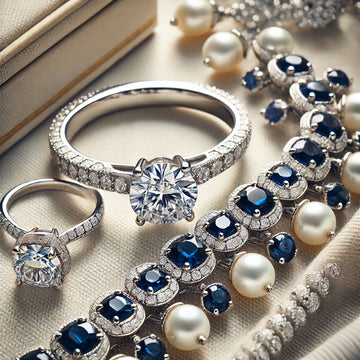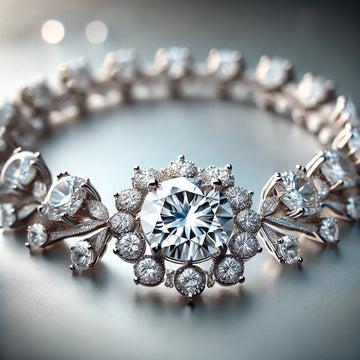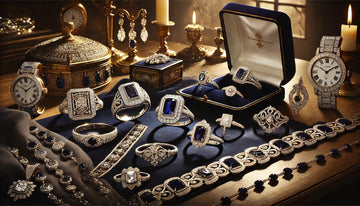
Materials in Fine Jewelry
One of the defining features of fine jewelry is the use of high-quality, precious materials. The value of fine jewelry comes not only from the craftsmanship involved in creating it but also from the rarity and beauty of the materials used. Below, we explore some of the most common and prized materials in fine jewelry.
https://ivevar.com/products/handcrafted-natural-diamond-pendant-necklace-by-ivevar
Precious Metals
The foundation of most fine jewelry pieces is the metal from which they are made. The most commonly used precious metals in fine jewelry are gold, platinum, and silver, though there are also rarer metals like palladium and rhodium that sometimes make their way into high-end designs.- Gold : Gold is perhaps the most iconic metal used in fine jewelry, valued for its malleability, resistance to tarnish, and warm, lustrous appearance. Gold is typically available in three colors: yellow, white, and rose. Pure gold (24 karat) is too soft for most jewelry, so it is often alloyed with other metals like silver, copper, or palladium to increase its durability. 18-karat and 14-karat gold are the most common alloys used in fine jewelry.
- Platinum : Platinum is a dense, durable metal that has gained popularity in fine jewelry due to its strength and elegant, silvery-white sheen. Unlike gold, which is often alloyed with other metals, platinum used in jewelry is typically 95-98% pure. Its durability makes it an ideal choice for rings, particularly those set with diamonds or other precious stones, as it holds the stones securely and resists scratching.
- Silver : Silver has been used in jewelry for centuries and is valued for its affordability and bright, reflective finish. Sterling silver, an alloy made of 92.5% pure silver and 7.5% copper or other metals, is the standard for fine silver jewelry. While silver is more affordable than gold or platinum, it is also softer and more prone to tarnishing, so it often requires more maintenance to keep it looking its best.
Gemstones
Precious and semi-precious gemstones are the centerpiece of many fine jewelry designs. These stones are valued for their beauty, rarity, and symbolic meanings. The most popular gemstones used in fine jewelry include diamonds, sapphires, rubies, and emeralds, though there are countless other stones, each with its own unique qualities.
- Diamonds : Diamonds are the most iconic and widely recognized gemstones in fine jewelry. Known for their brilliance and hardness (they are the hardest natural substance on Earth), diamonds have become synonymous with luxury and love, particularly in engagement rings. Diamonds are graded based on the "Four Cs": carat weight, cut, color, and clarity, with larger and higher-quality diamonds being the most valuable.
- Sapphires : Sapphires are best known for their rich blue color, but they can actually come in a variety of hues, including pink, yellow, and green. Sapphires are prized for their beauty and durability, making them a popular choice for both rings and necklaces. Blue sapphires, in particular, are associated with loyalty, wisdom, and nobility.
- Rubies: Rubies are another highly prized gemstone, valued for their deep red color and rarity. They are made from the mineral corundum (the same mineral that makes up sapphires), but the presence of chromium gives rubies their distinctive red hue. Rubies are often associated with passion, love, and courage.
- Emeralds : Known for their vibrant green color, emeralds have been a symbol of fertility, rebirth, and love for centuries. Like rubies, emeralds are relatively soft compared to diamonds and sapphires, so they require more care and attention when used in jewelry. Despite their fragility, emeralds are highly valued for their rich color and rarity.
Pearls
Pearls hold a special place in the world of fine jewelry, as they are the only gemstone created by living organisms. Natural pearls, which are formed when an irritant enters an oyster or mollusk and is coated in layers of nacre, are extremely rare. Most pearls used in jewelry today are cultured pearls, which are created by manually inserting an irritant into the oyster to stimulate the production of nacre.Pearls come in a variety of colors, including white, cream, pink, and black, and their luster and surface quality are key factors in determining their value. While pearls have traditionally been associated with classic, elegant designs, modern jewelers are increasingly incorporating them into contemporary settings.
Craftsmanship in Fine Jewelry
One of the key elements that distinguishes fine jewelry from mass-produced or costume jewelry is the level of craftsmanship involved in its creation. Fine jewelry is often made by skilled artisans who spend hours, or even days, carefully crafting each piece by hand. This attention to detail ensures that the finished product is not only beautiful but also durable and designed to last for generations.
Handcrafted vs. Machine-Made
Many high-end fine jewelry pieces are still made using traditional techniques, such as hand engraving, hand setting of stones, and hand polishing. These methods require a high level of skill and precision, and the resulting pieces are often considered works of art in their own right. Jewelers who specialize in handcrafted pieces may use techniques passed down through generations, ensuring that each piece is unique and made with the utmost care.
In contrast, machine-made jewelry is often produced on a larger scale and may not have the same level of intricate detailing as handcrafted pieces. However, advances in technology have allowed for machine-made jewelry to reach a higher level of quality, with computer-aided design (CAD) and 3D printing allowing for more precise and complex designs.
Setting and Mounting
The way in which gemstones are set in fine jewelry is a crucial aspect of craftsmanship. There are several different techniques for setting stones, each of which affects the overall appearance and security of the piece.
- Prong Setting : This is one of the most common settings for engagement rings and other fine jewelry pieces. In a prong setting, metal claws hold the gemstone in place, allowing light to pass through the stone and enhance its brilliance. While prong settings provide a secure hold, they can also be prone to catching on clothing, so care must be taken to ensure the prongs are not too high or sharp.
- Bezel Setting : A bezel setting surrounds the gemstone with a rim of metal, which holds the stone securely in place while also protecting it from damage. This setting is particularly popular for softer gemstones, like emeralds, that may be more prone to chipping. Bezel settings offer a sleek, modern look and are ideal for everyday wear.
- Pavé Setting : In a pavé setting, small gemstones are set closely together, with tiny beads of metal holding them in place. This technique creates the appearance of a continuous surface of glittering stones and is often used in wedding bands or cocktail rings to add extra sparkle.
Role of Fine Jewelry in Celebrating Milestones
Fine jewelry is often chosen to mark significant life events, such as engagements, weddings, anniversaries, and the birth of a child. These pieces serve as lasting reminders of special moments and are often passed down through generations as heirlooms.
- Engagement Rings : Perhaps the most iconic piece of fine jewelry is the engagement ring, traditionally given as a symbol of a commitment to marriage. While diamonds are the most popular choice for engagement rings, many couples today are opting for alternative gemstones or custom designs that

 Engagement Ring
Engagement Ring  Anniversary Rings
Anniversary Rings Solitaire Rings
Solitaire Rings Halo Rings
Halo Rings Men's Ring
Men's Ring Toi Moi Ring
Toi Moi Ring Three Stone Rings
Three Stone Rings Nature Inspired Rings
Nature Inspired Rings Rose Cut Diamond Rings
Rose Cut Diamond Rings Fancy Color Rings
Fancy Color Rings Antique Cut Diamond Rings
Antique Cut Diamond Rings Wedding rings
Wedding rings All Lab Grown Diamond Ring
All Lab Grown Diamond Ring Engagement Ring
Engagement Ring  Three Stone Rings
Three Stone Rings Daily Wear
Daily Wear Fancy Color Rings
Fancy Color Rings Antique Cut Diamond Rings
Antique Cut Diamond Rings Earrings
Earrings Bracelet
Bracelet Pendent
Pendent Necklace
Necklace Rings
Rings Earrings
Earrings All Rainbow Collection
All Rainbow Collection Tennis chain
Tennis chain Custom Pendent
Custom Pendent Custom Ring
Custom Ring Custom Teeth Grillz
Custom Teeth Grillz Round
Round Oval
Oval Cushion
Cushion Marquise
Marquise Pear
Pear Emerald
Emerald Heart
Heart Princess
Princess Rose Cut
Rose Cut Radiant
Radiant Antique Cut
Antique Cut Regular Cut
Regular Cut Cushion
Cushion Men's Ring
Men's Ring Bridal Sets
Bridal Sets



